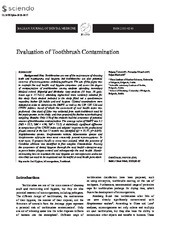Приказ основних података о документу
Evaluation of toothbrush contamination
| dc.creator | Ćetenović, Bojana | |
| dc.creator | Zdravković, Nemanja | |
| dc.creator | Marković, Dejan | |
| dc.date.accessioned | 2020-07-02T13:23:03Z | |
| dc.date.available | 2020-07-02T13:23:03Z | |
| dc.date.issued | 2019 | |
| dc.identifier.issn | 2335-0245 | |
| dc.identifier.uri | https://smile.stomf.bg.ac.rs/handle/123456789/2405 | |
| dc.description.abstract | Background/Aim: Toothbrushes are one of the main means of cleaning teeth and maintaining oral hygiene, but toothbrushes are also potential reservoir of microorganisms, including pathogens. The aim of this paper was to evaluate the oral health, oral hygiene awareness and assess the degree of contamination of toothbrushes among students attending Secondary Medical School. Material and Methods: Sixty students (32 boys, 28 girls; mean age ≅ 15,7±2,1) attending highschool were randomly selected for this study. Each student included in the study filled out a questionnaire regarding his/her life habits and oral hygiene. Clinical examinations were initiated in order to determine the DMFT, as well as the CIP, CIT, CIA and CPITN indexes, based of which the assessment of oral health status was performed. One stack of fiber was collected from each toothbrush used by the participantes in the study, and than prepared for further microbiological sampling. Results: Only 11% of the students had the awareness of potential sources of toothbrushes contamination. The average value of DMFT was 3,2 (%D = 22,5; %M = 4,96; %F = 72,5). A statistically significant difference in comparison of the CPITN index and subjects' response to the professional plague removal in the last 12 months was identified (χ2 = 13,55; p= 0,033). Staphylococcus aureus, Streptococcus mutans, Micrococcus species and Streptococcus salivarius were most commonly present microorganisms. In most cases, G-positive bacilli or cocci were isolated, while the presence of Candidae albicans was identified in four samples. Conclusions: Raising the awareness of dental hygiene through the oral health education may improve better plaque control and subsequently the oral health. Hands-on training how to maintain the oral hygiene are not expensive and more over they are easy to be organized can be useful in oral heath promotion. | en |
| dc.publisher | Udruženje stomatologa Balkana | |
| dc.rights | openAccess | |
| dc.rights.uri | https://creativecommons.org/licenses/by-nc-nd/4.0/ | |
| dc.source | Balkan Journal of Dental Medicine | |
| dc.subject | oral hygiene | en |
| dc.subject | microorganisms | en |
| dc.subject | toothbrush | en |
| dc.title | Evaluation of toothbrush contamination | en |
| dc.type | article | |
| dc.rights.license | BY-NC-ND | |
| dcterms.abstract | Ћетеновић, Бојана; Здравковић, Немања; Марковић, Дејан; | |
| dc.citation.volume | 23 | |
| dc.citation.issue | 2 | |
| dc.citation.spage | 93 | |
| dc.citation.epage | 97 | |
| dc.citation.other | 23(2): 93-97 | |
| dc.citation.rank | M51 | |
| dc.identifier.doi | 10.2478/bjdm-2019-0017 | |
| dc.identifier.fulltext | https://smile.stomf.bg.ac.rs/bitstream/id/939/2400.pdf | |
| dc.type.version | publishedVersion |


